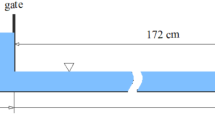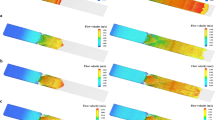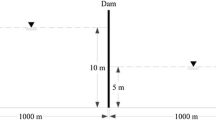Abstract
The three-dimensionality extent of the dam break flow over a vertical wall is investigated numerically and experimentally in this paper. The numerical method is based on Reynolds averaged Navier-Stokes (RANS) equation that describes the three-dimensional incompressible turbulent flow. The free surface is captured by using the unstructured multi-dimensional interface capturing (UMTHINC) scheme. The equations are discretized on 2-D and 3-D unstructured grids using finite volume method. The numerical simulations are compared with newly conducted experiment with emphasis on the effect of three-dimensionality on both free surface and impact pressure. The comparison between the numerical and experimental results shows good agreement. Furthermore, the results also show that 3-D motion of the flow originates at the moment of impact at the lower corners of the impact wall and propagates to the inner region as time advances. The origin of the three-dimensionality is found to be the turbulence development as well as the relative velocity between the side wall region and the inner region of the wave front at the moment of impact.
Similar content being viewed by others
References
Dressler R. F. Comparison of theories and experiments for the hydraulic dam-break wave [J]. International Association of Hydrological Sciences, 1954, 3(38): 319–328.
Lauber G., Hager W. H. Experiments to dambreak wave: Horizontal channel [J]. Journal of Hydraulic Research, 1998, 36(3): 291–307.
Martin J., Moyce W. An experimental study of the collapse of liquid columns on a rigid horizontal plane [J]. Philosophical Transactions of the Royal Society of London A: Mathematical, Physical and Engineering Sciences, 1952, 244(882): 312–324.
Koshizuka S., Oka Y. Moving-particle semi-implicit method for fragmentation of incompressible fluid [J]. Nuclear Science and Engineering, 1996, 123(3): 421–434.
Gomez-Gesteira M., Dalrymple R. A. Using a three-dimensional smoothed particle hydrodynamics method for wave impact on a tall structure [J]. Journal of Waterway, Port, Coastal, and Ocean Engineering, 2004130(2): 63–69.
Hu C., Kashiwagi M. A CIP-based method for numerical simulations of violent free-surface flows [J]. Journal of Marine Science and Technology, 2004, 9(4): 143–157.
Hu C., Sueyoshi M. Numerical simulation and experiment on dam break problem [J]. Journal of Marine Science andApplication, 2010, 9(2): 109–114.
Kleefsman K. M. T., Fekken G., Veldman A. E. P. et al. A volume-of-fluid based simulation method for wave impact problems [J]. Journal of Computational Physics, 2005, 206(1): 363–393.
Lobovsky L., Botia-Vera E., Castellana F. et al. Experimental investigation of dynamic pressure loads during dam break [J]. Journal of Fluids and Structures, 2014, 48: 407–434.
Zhou Z. Q., Kat J. O. D., Buchner B. A nonlinear 3D approach to simulate green water dynamics on deck [C]. Seventh International Conference on Numerical Ship Hydrodynamics, Nantes, France, 1999.
Park I. R., Kim K. S., Kim J. et al. Numerical investigation of the effects of turbulence intensity on dam-break flows [J]. Ocean Engineering, 2012, 42: 176–187.
Sueyoshi M., Hu C. Experimental technique and particle simulation for large deformation problems of free-surface [C]. Conference Proceedings of Japan Society of Naval Architects and Ocean Engineers, Japan Society of Naval Architects and Ocean Engineers, Tokyo, Japan, 2015, 93–94.
Ye Z., Zhao X., Deng Z. Numerical investigation of the gate motion effect on a dam break flow [J]. Journal of Marine Science and Technology, 2016, 21(4): 579–591.
Xiao F., Honma Y., Kono T. A simple algebraic interface capturing scheme using hyperbolic tangent function [J]. International Journal for Numerical Methods in Fluids, 2005, 48(9): 1023–1040.
Ii S., Sugiyama K., Takeuchi S. et al. An interface capturing method with a continuous function: The THINC method with multi-dimensional reconstruction [J]. Journal of Computational Physics, 2012, 231(5): 2328–2358.
Xie B., Ii S., Xiao F. An efficient and accurate algebraic interface capturing method for unstructured grids in 2 and 3 dimensions: The THINC method with quadratic surface representation [J]. International Journal for Numerical Methods in Fluids, 2014, 76(12): 1025–1042.
Ii S., Xie B., Xiao F. An interface capturing method with a continuous function: The THINC method on unstructured triangular and tetrahedral meshes [J]. Journal of Computational Physics, 2014, 259: 260–269.
Xie B., Jin P., Xiao F. An unstructured-grid numerical model for interfacial multiphase fluids based on multi-moment finite volume formulation and THINC method [J]. International Journal of Multiphase Flow, 2017, 89: 375–398.
Deshpande S. S., Anumolu L., Trujillo M. F. Evaluating the performance of the two-phase flow solver interFoam [J]. Computational Science and Discovery, 2012, 5(1): 14016.
Launder B. E., Spalding D. B. The numerical computation of turbulent flows [J]. Computer Methods in Applied Mechanics and Engineering, 1974, 3(2): 269–289.
Moukalled F., Mangani L., Darwish M. The finite volume method in computational fluid dynamics: An advanced introduction with OpenFOAM and Matlab, fluid mechanics and its applications [M]. London, UK: Springer International Publishing, 2015.
Ferziger J. H., Peric M. Computational methods for fluid dynamics [M]. Berlin Heidelberg: Springer, 2012.
Ubbink O. Numerical prediction of two fluid systems with sharp interfaces [D]. Doctoral Thesis, London, UK: University of London, 1997.
Van Leer B. Towards the ultimate conservative difference scheme. II. Monotonicity and conservation combined in a second-order scheme [J]. Journal of Computational Physics, 1974, 14(4): 361–370.
Versteeg H. K., Malalasekera W. An introduction to computational fluid dynamics: The finite volume method [M]. London, UK: Prentice Hall, 2007.
Maric T., Marschall H., Bothe D. voFoam-A geometrical volume of fluid algorithm on arbitrary unstructured meshes with local dynamic adaptive mesh refinement using OpenFOAM [J]. Physics, 2013.
Gottlieb S., Shu C. W. Total variation diminishing Runge-Kutta schemes [J]. Mathematics of Computation, 1998, 67(221): 73–85.
Ritter A., Die Fortpflanzung der Wasserwellen [J]. Zeitschrift Verein Deutscher Ingenieure, 1892, 36(33): 947–954.
Author information
Authors and Affiliations
Corresponding author
Rights and permissions
About this article
Cite this article
Kamra, M.M., Mohd, N., Liu, C. et al. Numerical and experimental investigation of three-dimensionality in the dam-break flow against a vertical wall. J Hydrodyn 30, 682–693 (2018). https://doi.org/10.1007/s42241-018-0074-x
Received:
Revised:
Accepted:
Published:
Issue Date:
DOI: https://doi.org/10.1007/s42241-018-0074-x




